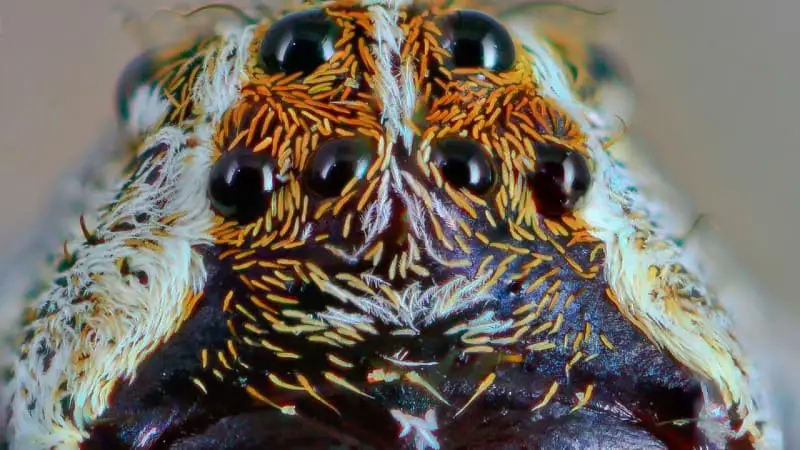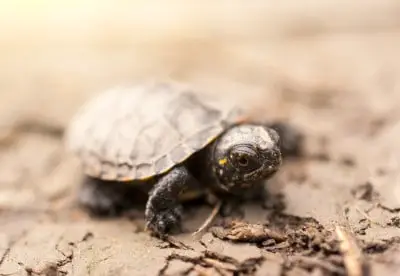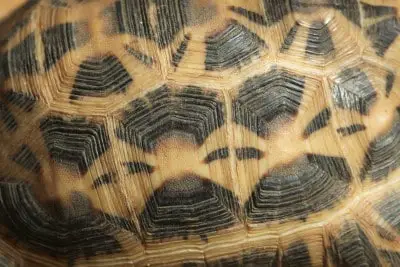How far can spiders see? Spiders have so many eyes, so their vision must be perfect, right?
Actually, no. Spiders have distinctly poor eyesight even with so many eyes. Most spiders can only detect two meters or less in front of them.
So how does a spider interact with its surroundings? And, what can they comprehend?
Spiders have 8 eyes as most of us know, but their vision is poor. The eye of the spider has only an angle of two to five degrees, in which the spider can observe its world.
This means the spider must interact with its environment differently.

How Far Can Spiders See?
Most spiders can detect movement with their eyes, but can also detect vibrations. Web spinning spiders detect the slightest of vibrations.
They actually will retreat into the shade during the day so that they aren’t visible to their predators. But, they will put one or two of their legs on the web to detect the vibration of their prey.
This is how male spiders let the female spider know they are present.
They don’t want the female to presume they are prey, so they have a species specific way to vibrate the web with a gentle wave instead of the panicked thrashing an insect can display.
Most spiders are nocturnal, so you would expect they see better at night. But, it’s not the case. Spiders may detect motion at night but don’t have any significant change in their vision.
Most spiders are near-sighted and don’t see far at all.
Near-sighted means your vision is the most perfect near you rather than far away. There are spiders active during the day, and they are called diurnal.
These spiders generally have better vision and are attracted to the light.
Read more Do Pet Spiders Recognize Their Owners?
Can Spiders Hear?
In recent years, it has come to the attention of scientists that spiders do actually hear. Until recently, scientists believed the spiders only perceived vibration.
But, while doing a study on the jumping spider’s brain pathways, a jumping spider’s neurons fired when the chair of the scientist squeaked.
The scientist was so excited by this he repeated the motion. And, again, the neuron fired. He continued by clapping his hands at different distances.
The neuron continued to fire until he was five meters away. It was determined the jumping spider could actually hear. But, the spider doesn’t have ears!
Continuing the experiment, the scientists added droplets of water to the tiny hairs on the spider’s legs. They repeated the process over and nothing happened.
The spider actually hears through the hairs on its legs and pedipalps.
However, the experiment was only completed on the jumping spider. It’s possible other spiders hear too.
The sounds that the jumping spider heard were low tones like the sound of a deep male voice. This is how the spider can evade predators as they can hear the beat of the wasp’s wings.
Can Spiders Smell?
Spiders definitely can smell.
Each spider emits pheromones and a male spider can smell the pheromones of the female and reach her to mate.
They have sensory hairs all over their body, but most of the pheromones tend to come from the silk used to construct their web.
It is unable to be determined if a spider smells anything other than the pheromones, but in studies done with a male spider, on silk without pheromones, the male spider doesn’t react.
That’s not to say they don’t smell other items, it simply means we aren’t sure.
Can Spiders Taste?
Spiders do have a sense of taste.
They distinguish, through vibration on their web, each prey caught there. This is how the spider knows how to approach the prey. It certainly can’t be from sight.
However, those fine hairs not only perceive vibration, they also smell and taste for the spider as well.
Back to Sight
Not all spiders have eight eyes. Some spiders have six eyes.
Spiders have two sets of eyes. Primary and secondary eyes.
- The primary eyes are the largest of the eyes and help the spider to distinguish form.
- The secondary eyes can be arranged anywhere on the spider’s head and can be lined underneath the primary eyes or separated and be on the side of the head.
But, there are 40,000 types of spiders and no two look alike.
The primary eyes face forward and have muscles to assist them to move in all directions. But, the secondary eyes don’t. The secondary eyes are stationary.
But there is a species of spider without any eyes at all. This is the blind cave dweller.
Because they never leave the darkness of the cave, they have adapted over the years. And they have no eyes. They use all their other senses to survive without sight.
But, jumping spiders have the greatest vision of all the spiders. Some species of spiders actually hunt for their prey. They are called hunters or wanders.
These spiders are spiders who hunt on the forest floor. They hide in burrows or bushes. They spin a web in the burrow and wait at the bottom of the web. When they feel the vibration of the prey on the web, they pounce.
Another spider in this group builds a funnel shaped web. The spider waits for the prey to enter the tube and then eats his dinner.
However, jumping spiders are also in the hunter group. The jumping spider visualizes his prey and jumps up to get it.
The jumping spider can jump 25-50 times its length. So, common sense would say the jumping spider can distinguish its prey.
What About Color?
Jumping spiders have a colorful pattern on their back. This is how the jumping spider recognizes a mate.
A scientist wondered if the jumping spider could actually distinguish colors. The theory is a jumping spider must visualize color or why have all the colorful patterns on their back.
It’s been determined the jumping spider can discern color. They perceive color like humans perceive color. Well, almost.
Jumping spiders can identify the colors red, green, yellow and orange. But jumping spiders also distinguish ultraviolet light.
The female jumping spider fluoresces green under UV light, and this attracts the male jumping spider.
But, the female jumping spider observes the male as the male has scales on its face which reflect UV light. This appears to start an amorous connection.
UV light is important for another reason. Spiders, that are active during the day, need the UV light to strengthen their silk.
This helps prevent them from becoming prey and strengthens their defense mechanisms.
All these factors together show how a spider can survive in its environment without the assistance of keen sight.
Final Word
Spiders can taste, sense, smell and touch their environment even if they don’t have excellent sight.
Animals like spiders learn to adapt and use whatever skills they have to overcome the ones they don’t. Spiders are no different.
Spiders can’t see far. Most can distinguish motion and shape.
But their vision doesn’t change at night. But, there are spiders who can distinguish color and further distances. Adapting is the name of the game and spiders know how to do it and do it well.








